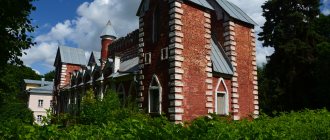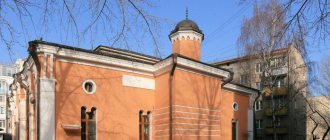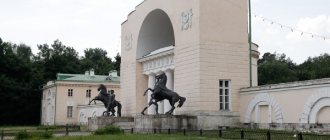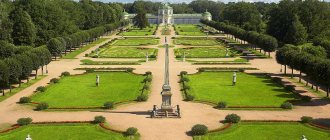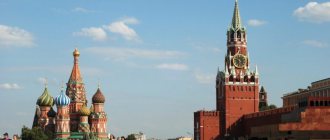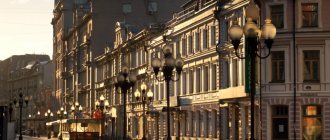| – Sights – Ancient estates – Museums – Vacation spots – Reviews, stories and routes of tourists – Excursions to Podolsk for one day |
Quarters on the banks of the Pakhra River, bearing the legacy of Tsarist Russia and the austerity of the Soviet era, surrounded by many industrial enterprises, interspersed with public gardens and forest parks - this is one of the largest cities in the Moscow region - Podolsk.
Podolsk is located south of Moscow, 15 km from the Moscow Ring Road and not far from the M-2 Crimea highway, connecting the region with the southern regions. Proximity to the capital and a major highway is an important point that determines the development of the city both now and once influenced the fate of the small village of Podol.
In 1781, Catherine the Great granted the village the status of a city. At the same time, the coat of arms of Podolsk was formed, which then changed its appearance more than once, but the two crossed pickaxes remained unchanged. They pay tribute to the past dignity of the village and symbolize its original occupation - the extraction of limestone.
Even before the establishment of Soviet power, Podolsk was actively involved in industrial life: factories appeared - a brewery, a brick factory, famous throughout the country for Singer sewing machines and others. At the same time, educational and cultural institutions were built and commercial enterprises opened.
Lenin Avenue Photo: © Nomad
During the Soviet period, after an initial slight decline, manufacturing enterprises were revived with even greater force: old ones were modernized and new ones were built, capturing ever larger areas and absorbing neighboring villages. At the same time, the population is growing, new residential areas and a corresponding culture are being formed.
On the streets of Podolsk you can still find both stories, merchants of the 18th-19th centuries. and Soviet XX century. They overlap each other, complementing and forming their own unique image of the city.
You can go for a walk around it yourself by studying this guide or city guide. A guided tour will tell you in more detail about all the transformations. For residents and guests of Moscow and the Moscow region, a trip to Podolsk is an interesting option for a weekend tour, in which you can combine an educational program and various recreational opportunities.
Banks of Pakhra in the vicinity of the city Photo: © Nomad
Some historical and modern information
Little information has been preserved about the ancient times of Podolsk. Thanks to archaeological finds, it has been established that those places were inhabited by Finno-Ugric tribes. Their main occupation is agriculture and crafts. They mainly made pottery without using a potter's wheel.
There is a legend that the city was named so thanks to Catherine II. When she passed through the city, she soaked the hem of her dress in the river. However, this legend is unlikely to have anything to do with the name. The years of her reign were 1762-1796. And mentions of the local village of Podol, which became the basis of the city, are found in documents from 1559, remaining from the time of Ivan the Terrible.
But the city was created precisely by her decree in 1781. The number of inhabitants of that period was 856 people. They were mainly engaged in the extraction of rubble and white stone. During her reign, they developed a rectangular plan with a longitudinal-transverse grid of city streets.
Most of the houses were built from “Podolsk marble”. This was the name of the local stone and rubble.
A more likely version is that the name of the city comes from the word “podol”, meaning “the side of a mountain, hill, hill” or “a low place under a mountain.” Usually such settlements arose near rivers. They are typical for many ancient Russian cities.
There is a third version, which says that the village was located along the valley of 2 rivers - Pakhra and Mocha.
For a long time it was a quiet provincial town. Noble people, merchants, and wealthy artisans settled on the high bank of the river, and the poor lived on the opposite side, which was often flooded.
Podolsk in an old photo
The incentives for the development of Podolsk were:
- opening of the Warsaw highway;
- construction of a bridge across the Pakhra River.
The city established the work of the Porokhovshchikov cement plant, a factory, and later a cable plant. So the merchant town gradually turned into an industrial center.
The beginning of the 20th century was marked by the opening of a cinema, a water supply system, a water tower, and an electrical station. After 1920, radio broadcasting and bus service began. In the next decade, several factories were put into operation: a battery plant, a fruit water plant, a foundry and rolling plant, a bakery plant, and a meat processing plant.
Residents of Podolsk have always participated in major historical events:
- The peasants distinguished themselves in the partisan movement during the Patriotic War of 1812. Kutuzov’s army was also stationed in these places.
- The residents of Podolsk did not remain indifferent to the revolutionary events of 1917.
- During the Great Patriotic War, over 30 thousand people went to the front. They bravely defended the last lines leading to Moscow. The cadets of the military school distinguished themselves. Thanks to them, it was possible to raise reserves to defend the capital.
The intersection of Kirov, Parkovaya and Archive Proezd streets is decorated with a monument to cadets, erected in 1975
Young cadets with poor weapons fought for almost two weeks with the Nazis who were trying to break through to Moscow. Of the 3.5 thousand people, about a thousand survived after the battle.
During the Soviet years, surrounding villages were annexed to the city limits.
Modern Podolsk is a city with large factories and modern houses. Its peculiarity is its sprawling territory with many districts.
In the center is Lenin Square with administrative buildings, institutions, and the Exhibition Hall. Streets diverge from it in several directions:
- Lenin Avenue stretches to the northeast. From here begins the path of those who want to see the bridge over the Pakhra River, the Podolia Museum, and get acquainted with the northern part of the city, the Novosyrovo microdistrict, and the Podolsk DSK.
- Komsomolskaya Street is directed to the northwestern and southeastern parts.
- Bolshaya Serpukhovskaya Street will lead to the south. There are PEMZ, Detsky Mir, and the Kutuzovo and Klimovsk microdistricts.
- You can get to the southwest from Sverdlov and Kirov streets.
The Pakhra River separates the northern part of the city from the center.
In the central part you can see the layout of 1784 (in the area of the Trinity Cathedral) and residential buildings from the late 19th and early 20th centuries.
The reconstruction of the city took place after 1950. New neighborhoods have sprung up. The Bolshoi Podolsk project has been implemented.
Interesting to know. The city is divided by an hour meridian. Having moved from the eastern part to the western part or vice versa, you find yourself in an area where the time differs by one hour.
The bus station and the Podolsk railway station are located in the same place - in the city center. In addition, there are also railway stations: Silikatnaya, Kutuzovskaya, Grivno, Vesennyaya, Lvovskaya. The last three were added after the annexation of the city of Klimovsk and the workers' village of Lvovsky to Podolsk. Public transport includes buses, trolleybuses, and minibuses.
The city is located very close to Moscow - only 15 km. Therefore, some of its residents work in the capital. The opposite situation is also observed - people working in Moscow rent housing in Podolsk, since rent there is much cheaper.
Getting from Moscow to Podolsk is easy:
- There are many train flights from Kursky Station. The interval between them is half an hour. The duration of the trip is one hour.
- Buses run even more often than trains. They depart from the metro stations: Dmitry Donskoy Boulevard, Annino, Yuzhnaya. The fare is cheaper than by rail. The entire route is covered in 30-60 minutes. The presence of traffic jams plays a role.
- You can get there by personal car or taxi by driving along the Warsaw or Simferopol highway.
In Podolsk there are attractions of any kind: religious and architectural monuments, many simply beautiful and interesting places. Let's look at the main ones.
Recreation places
The introduction to Podolsk will be complemented by its popular holiday destinations. In the surrounding area there are several forest parks and untouched forests; in the city itself there are public gardens and walking areas, entertainment venues with quests, trampolines and other activities. Much of the above can be found anywhere in the country, so we will only indicate unique places where adults and families with children can leisurely spend part of a one-day trip around Podolsk.
Talalikhina Park
The main park of Podolsk is the Talilikhin Park and Park, located north of the railway station on the right bank of the Pakhra. The location of part of the territory on a hill allows you to rise slightly above the buildings and appreciate the panorama of the city. At the entrance to it from the street. The worker installed a bust of V. Talilikhin, a military pilot who shot down enemy planes in 1941 near Moscow and was subsequently awarded the title of Hero of the USSR.
Hidden among the lush greenery is a children's playground and children's attractions - carousels, swings, a Ferris wheel and trampolines. There are sports courts, a stage and a dance floor, which serve as a venue for festive city events. In summer it’s good to walk here, ride a bike along the paths or sunbathe on the wild beach near Pakhra. In winter, go ice skating or join in the traditions by plunging into the Epiphany font.
Read more: Talalikhin Park in Podolsk
Belyaevsky Beach
Those who come for a walk in the summer will not refuse the coolness of the river. One of the largest beaches near the center of Podolsk runs along Belyaevskaya Street. The low bank along Pakhra is rich in emerald vegetation, framing the sparkling mirror of water. In the western part of the panorama one can see the top of the Znamenskaya Church in Dubrovitsy.
The sandy and grassy shore is equipped with a small number of wooden sun loungers, a changing room, and a toilet. During the season there is a cafe on it. In addition to barbecue, vacationers' leisure time is diversified by a sports and children's playground, and boat rentals. It is worth noting that there is a steep path leading from the street to the shore.
Read more: Belyaevsky Beach
Belyaevsky Beach Photo: © Elena Mukhlyarits
Ski resort "Krasnaya Gorka"
The Moscow region is not famous for its high mountains, but Podolsk has its own ski resort located near the dam, on the steep left bank of the Pakhra. This is the best option to diversify your route by spending a couple of hours active skiing, snowboarding or tubing. The length of the ski slopes is 100–380 meters, and is well suited for beginners; in addition, there is a ski school for adults and children. If you happen to drop by, rentals will come in handy: everything you need for the appropriate equipment is available for rent. And, of course, you can warm up and refresh yourself in the cafe on site.
Read more: ski resort "Krasnaya Gorka" in Podolsk
Slope of the “Red Hill” Photo: © Alexander P.
Church of the Blessed Virgin Mary in Dubrovitsy
It was built in 1704. It is distinguished by its majesty and uniqueness, unusual architecture for Russian architecture since designs of Russian and Italian masters were used.
Its peculiarity is its decoration with carvings, ornamental patterns and sculptural images of Gregory the Theologian and John Chrysostom with books.
The opening and consecration of the temple took place in the presence of Peter I.
At first it was a small church made of wood in the name of the prophet Elijah. Later she was moved to a nearby village.
White stone was used for construction. Style - Baroque. The height of the temple is more than 42 m.
European architects worked on the construction of the building. They decorated it in the style of Faberge's jewelry masterpieces. The decorations inside the church are quite unusual for Russian churches - white sculpture and stucco on a sky-blue background.
The temple vault is crowned with a gilded metal crown. Above the entrance you can see a wooden choir consisting of 2 tiers. They are made in Baroque style.
The interior decoration consists of sculptural compositions on biblical themes. The attention of visitors is attracted by the sculptural composition “The Crucifixion”.
Church of the Blessed Virgin Mary in Dubrovitsy
There is no bell tower as such. It is replaced by a row of bells hanging on the street near the temple.
The church was restored three times. The change of power affected its existence - it was closed and the domes were removed. Worship services resumed in 1990.
Address: pos. Dubrovitsy. Anyone can visit the temple. Working hours: from 9.00 to 17.00. Getting to it is easy - take bus No. 65 to the Dubrovitsy stop.
Tornado Fountain
Address: General A.S. Square Eremeeva (next to the Oktyabr cultural center)
Tornado is a light and music fountain-attraction with RGB LED spotlights. The height of its jets can reach 12 meters. The fountain is pedestrian, you can walk along it to refresh yourself during the day, and in the evening there is a beautiful light and music show.
Trinity Cathedral
In honor of commemorating the victory of the Russian army in the War of 1812, this cathedral was erected between 1819 and 1832. The cathedral is visible from afar as it is located on a hilly area.
It is made in the Empire style. A yellow color palette was used to decorate the façade, and colorfully decorated white elements were used for decoration. Five domes decorate the temple.
Exterior view of Trinity Cathedral
Adjacent to the main building is a bell tower with three tiers.
The main shrine of the temple is the miraculous icon of the Mother of God of Jerusalem. According to legend, she helped the residents of Podolsk get rid of the cholera epidemic in 1866. In addition to her, the cathedral contains particles of the relics of 140 saints.
Trinity Cathedral in Podolsk
The work of the temple did not stop even during Soviet times. Only the shopping arcades that complemented the architectural complex of objects were destroyed.
A Sunday school for children has been established. About 200 people study there.
Location: Cathedral Square, 3A. When using public transport, get to the Lenin Square stop.
Geographical location
Where the city of Podolsk is located becomes clear if you look at the map of the Moscow region. It is located south of Moscow. The urban district includes Podolsk itself and 75 rural settlements. Previously a district city, and since 2015 a city of regional subordination, it occupies an area of 339 km2.
If you are going to visit this part of the Moscow region and want to more accurately understand where the city of Podolsk is located, you should know that the district borders in the northeast with the Leninsky district, in the north, west and northwest - with Moscow, in the east - with Domodedovo, in the south - with the Chekhov district.
Church of the Resurrection of Christ
This is one of the oldest churches in the city. It was erected under Ivan the Terrible in the 16th century.
It was originally made of wood and lasted about 200 years. However, it burned down in a fire. The stone church was built in 1728. For a long time it remained the main temple of Podolsk.
After the War of 1812, it had to be rebuilt almost from scratch. However, church utensils were preserved thanks to the rector.
During the period of persecution of religion, it was left without domes and a bell tower. Its historical appearance was restored as a result of reconstruction. And during the Great Patriotic War, it housed a tank repair workshop.
Outwardly, it looks very modest - without painting.
The main relics of the temple are images with pieces of the relics of the Moscow saints and the Blessed Matrona.
Church of the Resurrection of Christ in Podolsk
It is located in a picturesque corner - on the banks of the Pakhra River on Krasnaya Street, 24. Next to it are train stations and Talalikhin Park. The church is open to visitors from 7.00 to 19.00. You can get there by buses No. 29, 3, 62, routes No. 3, 29, 4A.
Architectural structures
Podolsk, whose sights attract tourists interested in the history of the Moscow region, is surrounded by numerous noble estates. Many of them are in a ruined state, but there are also well-preserved or restored objects.
Dubrovitsy Estate
To the west of Podolsk in the village of Dubrovitsa, located on the banks of the Pakhra and Desna rivers, there is an estate of the same name, which belonged to the princes Golitsyn before the Revolution. The first owners of this land in the 17th century. Boyar Morozov appeared, who gave her as a dowry to his daughter, who married Prince Golitsyn.
In the next century, the estate for some time belonged to the favorites of Catherine II, Grigory Potemkin and Alexander Dmitriev-Mamontov. By the beginning of the 20th century. The Golitsyn princes collected a rich collection of works of art in their domains. The main house was furnished with luxurious furniture and had a large library.
Today, the estate palace, which is an architectural monument of the classical period, houses the All-Russian Institute of Animal Husbandry and the regional registry office. The remains of frescoes in the Armorial Hall remind us of the former splendor of the interior decoration.
The main treasure of Dubrovitsy is the famous Znamenskaya Church, built at the end of the 17th century. Boris Golitsyn. Also, lovers of quiet walks can take a walk on the banks of the Pakhra River or in the Linden Park, organized in the 18th century. according to the French model. Entrance to the church is open daily from 9 a.m. to 5 p.m. There is free parking next to the estate.
See also: Ulan-Ude. Sights of the city, photos with descriptions of what to see in a day
Ostafyevo Estate
The Ostafyevo country estate, located in the village of the same name north of Podolsk, is a historical place that belonged until 1918 to the noble families of Vyazemsky and Sheremetev. Many famous people of the 19th century visited here. A.S. Pushkin, N.V. stayed in the manor house, built in the style of classicism. Gogol, A.S. Griboedov, wrote his main work N.M. Karamzin.
At the end of the 19th century, the Pushkin Museum opened here, which existed until the 30s. XX century During the Soviet years, in a quiet picturesque place, various organizations were located that were actively rebuilding estate buildings. The status of a museum was returned to the Ostafyevo estate only in the late 80s. By this time, most of the exhibits were lost and transferred to other organizations.
Today, the Ostafyevo estate-museum is a popular recreational and educational place for residents of the Moscow region. Monuments to writers that appeared here in the pre-revolutionary period have been restored on the territory of the park.
The main building houses exhibitions on the following topics:
- history of the estate;
- life of N.M. Karamzin;
- estate interior of the 19th century.
In addition to the main exhibitions, there are temporary exhibitions and various educational events are held. You can enter the territory of the manor park from 8 to 22 in the summer, and from 8 to 20 in the winter. In this case, you must pay an entrance ticket, the cost of which is 50 rubles.
A private visit to the museum costs from 100 to 400 rubles, and photography throughout the estate is possible with a special ticket costing 100 rubles.
Merchant houses on Lenin Street
The development of the city and the expansion of modern buildings lead to the loss of urban architectural monuments of the 19th century. But in the area of Pobeda Avenue, buildings belonging to the 2nd floor development have been preserved. XIX - early XX century Two-story small houses made of stone and wood are reminiscent of what the city looked like at the beginning of its economic development.
Most of the surviving buildings are made of red brick and covered with light whitewash, on which white decorative details stand out.
The buildings that have been preserved in the best condition or have been successfully restored include the following objects:
- house of the merchant Borodachev (Pobeda Avenue, 93);
- house of the merchant Tolkushev (Pobedy Avenue, 138);
- house of the merchant Kananykin (Pobeda Avenue, 146);
- house of the merchant Solodkov (Karl Marx St., 33);
- house of the merchant Robinov (Lenin Ave., 100).
Today these buildings house shops and various government agencies.
Church of St. George the Victorious
It is considered one of the most beautiful buildings in the city. It was built in 2006-2007. Wood, used as the main building material, gives it a resemblance to ancient Russian tented churches. At the top it is crowned with five golden domes with crosses.
Church of St. George the Victorious
The St. George Sisterhood of Charity operates at the church. Its main goal is to provide medical and charitable assistance to large families, lonely and sick people.
It is located at the address: Bolshaya Serpukhovskaya Street, 93. Transport stop: “Kutuzovo-1”.
How to move more conveniently
The city has an extensive network of public transport, represented by the following means of transportation:
- city bus (48 rubles);
- trolleybus (48 rub.);
- minibus taxi (from 46 to 90 rubles).
Taxi services operating in the city can offer both economy class cars and luxury vehicles. The minimum cost of a trip around the city is 150 rubles. Podolsk is a small town near Moscow, which, despite its proximity to the capital, has not lost its charming provincial spirit.
Its attractions tell about the historical events that took place in these parts and the people who left a bright mark on the city's history.
Article design: Ilchenko Oksana
Church of Cyril and Methodius
This temple is a new Orthodox building, erected in 2011 in honor of the brothers who created Slavic writing.
The works are made of wood. On the facade you can see a golden dome with a cross. There is a bell tower nearby.
Church of Cyril and Methodius
The peculiarity of the temple is that it combines the heritage of ancient Russian architecture with the individuality of modern construction. The temple has a lot of light coming from large, tall windows. An atmosphere of cleanliness and space is created. The underground floor housed shops: a window shop and a book shop.
Address: Teplichnaya street, 1.
Fountain Natasha Rostova's first ball
Address: Podolsk, Kirova street, 31.
The fountain “Natasha Rostova’s First Ball” or “Lacy” is quite unusual. The sculptures of the fountain rotate in a waltz and refer to the leading actors in the famous film by S. Bondarchuk - L. Savelyeva and V. Tikhonov. Jets of water create a beautiful openwork mesh. Neon lighting in the evening makes the fountain even more beautiful.
Museums of Podolsk
The Podolia Museum-Reserve was created in the house where members of the Ulyanov family previously lived. V.I. Lenin visited him. The one-story house is located in a picturesque area, on the banks of the river.
The house where Lenin visited contains an authentic collection of items from that era. Excursions are held on the territory of the reserve, telling about the natural resources of the Moscow region.
In the museum-reserve Podolia
In the former Morozov estate, materials are presented that tell about the life, traditions, rituals of Podolsk merchants and townspeople of the 19th century, as well as about the finds of archaeologists from the Mesolithic times. Some exhibits existed 2-4 thousand years ago.
Address: Lenin Avenue, 47.
In 1977, the Podolsk Exhibition Hall was opened on Lenin Square. It was created to host photo and art exhibitions dedicated to the history of the area and its features.
Showroom
The exhibition hall area is 2000 m2. The sound and light effects used, music, and modern technology help to better perceive information.
Development
According to the described geographical location, it is quite clear where Podolsk is located. You won't have to travel long from Moscow. The distance from the center of the capital to the district along the highway is 38 km, which can result in a 20-30 minute drive.
The history of the city dates back to the 7th century BC. In the Dubrovitsky rural settlement, which now belongs to Podolsk, a site of primitive people who lived during the Mesolithic era was found. In the Iron Age, the city was inhabited by representatives of the Baltic and Finno-Ugric tribes. From the 9th-10th centuries AD. e. Slavs live in Podolsk.
It is believed that since the 11th century the city has belonged to the Smolensk principality. However, there are historians who disagree with this statement. Nevertheless, in the middle of the 14th century, the eastern part of the Smolensk Principality, together with the lands on which modern Podolsk stands, went to the Moscow Principality, and in 1559, part of the territory with the village of Podol that interests us was granted to the Danilov Monastery.
It is not very clear in what year the village of Podol was formed, but its development after becoming part of the monastery is quite easy to trace. It began its expansion from the initially formed place of residence at the bend of the Pakhra River, which was a waterway, and the path through the villages became a land road connecting Moscow with other principalities located in the west and south of Rus'.
In subsequent centuries, the development of Podol is associated with the Serpukhov road, which during the years of confrontation with the Crimean Khan acquired not only food, but also military-strategic importance. At the end of the 18th century, the settlement left the subordination of the monastery, and its residents began to pay taxes to the Moscow treasury, which significantly eased the situation of the peasants.
A little later, Podol was transformed into the city of Podol-Pehra, which became the center of the Podolsk district of the Moscow province. However, until the middle of the 19th century, village life was still characteristic of the settlement. It cannot yet be called a city inhabited by merchants and industrialists. Since the second half of the 19th century, a brewery, tannery, waxing and malting plant, brick factories and a cement factory appeared in Podol. The industrial development of Podolsk began. It is difficult to say which area of production was more successful in those years. Residents and industrialists did a little bit of everything. However, by the 20s of the 20th century, 95% of all goods exported from the city were directly related to construction. Many famous cultural heritage sites were built in the capital from materials produced in Podolsk.
In the post-war period, the construction of industrial facilities in the city continued at an accelerated pace, and the number of residents also grew. Podolsk became the first city in the Moscow region with a population of more than two hundred thousand people.
And in the 21st century, the city continues to be a leader in industrial production, having taken on additional workload and located on its territory a number of enterprises in the scientific industry, including those involved in atomic research.
Since 2004, the territory where Podolsk is located began to be called an urban district. In 2015, its area expanded significantly due to two former municipalities: the Podolsk municipal district and the urban district of Klimovsk.
Museum of Local Lore
The color and diversity of the exhibitions is amazing. Among them:
- archaeological finds from various eras;
- a collection of Singer sewing machines produced in Podolsk since 1902;
- materials telling about the feat of infantry school cadets; exposition “Podolsk Meridian”, dedicated to the fate of the city and its inhabitants.
Museum of Local Lore
The first exhibits for the exhibition, which took place at the end of the 19th century, were provided by the townspeople from their personal collections. People donated things of historical value. They served as the beginning of the creation of the museum. Income to its archival fund gradually increased. We had to move to more spacious premises.
Museum address: Sovetskaya Square, 7. By public transport, go to the “Market” stop.
We will tell you about the museums located on the territory of the Ivanovskoye estate below.
Nowadays
Now Podolsk is a modern and comfortable city. There are many large factories and other industrial facilities here. The houses are mostly left over from Soviet times, and new ones are being built, as a rule, further from the center. All stations are located in the center relatively close to each other. There are also trolleybuses in Podolsk, which recently introduced free Internet.
Podolsk has a rather elongated shape. Many districts are scattered far from each other, which is why in order to get from one part of the city to another you sometimes have to make a transfer, or even two. Unfortunately, this problem has not yet been resolved.
There are also a lot of traffic jams in the city, which has already become one of the most important problems of the Podolsk administration. So, it can take an hour to get from one area to another.
Its inconspicuous and gloomy appearance may also repel city guests. The houses are mostly grey, the area is cold and there is very little greenery. However, with each city, Podolsk is trying to improve as much as possible. New attractions are appearing and infrastructure is improving.
Estate Ivanovskoe
She is one of the business cards of Podolsk. Its owners for a long period were the Golovin family. In the 19th century, the estate became the property of Count Fyodor Tolstoy, the great-uncle of the famous writer. The appearance of the estate has been preserved precisely from the time of his ownership. At that time, the following appeared on the territory:
- manor house;
- outbuilding;
- greenhouse;
- theater.
Construction was continued by his heirs. They built a church. Added auxiliary buildings.
The main building is like a palace. The front side of the facade is decorated with a covered gallery with columns. Arches and loggias were created.
Ivankovskoye Estate
Today the estate houses:
- Museum of Vocational Education , established in 1987. Its goal is educational work among the younger generation. The area of the museum is more than 3000 m2. It houses 40 thousand exhibits. Particularly attractive is the exhibition with reliable documents, things that belonged to Peter I and the hall with materials about the exploits of teenagers who replaced mature men during the war. In the halls of the museum there are works of craftsmen from wood carvings, varieties of painting, handmade toys, lace.
- Branch of the local history museum with the exhibition “Nature of the Podolsk Territory”.
Location of the estate: Parkovaya street, 1.
Baths Alekseeva
Website: banialekseeva.ru Address: Podolsk, Kuznechiki microdistrict, st. Generala Smirnova, house 1, building 1. Opening hours: from 9.00 to 23.00, Tuesday - sanitary day.
One of the new attractions of Podolsk is Alekseeva Baths. This is the largest bathhouse complex in Russia, opened in 2021 as part of the governor’s program “100 bathhouses in the Moscow region.”
Alekseev Baths will delight you with the luxury and beauty of the interiors - in the style of European and Russian palace interiors of the 18th century. Sculptures, picturesque panels, mosaics, decorative elements made of marble, bronze and wood immerse you in a pleasant atmosphere.
Alekseev Baths provide a full range of bath services: a huge steam room for 100 people, a hammam, a cold plunge pool, barrels of ice water, a hydro pool, and delicious steam. There is a restaurant with craft beer and a store with bath products; additional paid services are provided (steaming, washing, peeling, tub-barrel with natural herbs).
Dubrovitsy Estate
People come to it not only because of the Temple of the Sign, but also to inspect the buildings themselves that belonged to the princes Golitsyn.
The first owners were the family of boyar Morozov. However, the main construction was carried out under Prince Golitsyn, who became the husband of Morozov’s daughter.
The main building was erected in the Baroque style at the beginning of the 18th century. The façade shows a combination of two styles – Baroque and Classical.
Later, the estate was owned by Prince Grigory Potemkin, Catherine II, Count Dmitriev-Mamontov.
Dubrovitsy Estate
The luxurious decoration of the halls was transferred to museums. But even now, in the Armorial Hall, the arches and walls with paintings remain unchanged.
There is a magnificent park nearby.
Interesting to know. The registry office is located in the estate area. After registration, the newlyweds visit the observation deck on the mound behind the temple. There they attach the lock.
Mound with observation deck Dubrovitsa
Weather, best time to travel
Podolsk is located in the temperate continental climate zone. Therefore, it is better to explore the city’s attractions in the summer, when the average temperature is 16-23 °C. In this case, you need to take care of having an umbrella, because in summer this area receives the most rainfall.
In winter, there is less precipitation, but due to the mild climate and the proximity of a large metropolis, which increases average temperatures, there is slush on city streets and country estates instead of snow.
You can clarify the climate picture of the region in the following table:
| Options/months | 01 | 02 | 03 | 04 | 05 | 06 | 07 | 08 | 09 | 10 | 11 | 12 |
| Precipitation, mm | 43 | 34 | 32 | 43 | 50 | 78 | 88 | 74 | 62 | 60 | 55 | 51 |
| Average temperature, °C | -9 | -8 | -3 | 5 | 12 | 16 | 23 | 18 | 10 | 4 | -1 | -6 |
Pleshcheyevo Estate
Stories about the city always mention this attraction. It is located in the eastern part of the city on the banks of the Pakhra River. There is a linden park next to the buildings.
The history of its origin begins in the 11th century. The first owner is Fedor Byakont. Then the owners changed several times. During the years Nadezhda von Meck owned the estate, the composer Tchaikovsky visited her in 1884-1885.
During Soviet times, various institutions and a dormitory for cement plant workers were located on its territory.
Pleshcheyevo Estate
Only part of the buildings has survived. They are used for housing. The park has been reduced. This area is not very prestigious, since it is located in an industrial zone.
The address of the estate: Pleshcheevskaya street, 57. You can get there by bus No. 24.
Where to go with a child
Podolsk has a lot of entertainment not only for adults, but also for children. From them you can choose an activity suitable for the time of year and age of the child.
Entertainment complex "Gorod"
The children's entertainment center “Gorod” is a three-story labyrinth for children from 3 to 12 years old. In it you can go through an obstacle course, ride a roller coaster, shoot from air cannons and dive into a pool with balls. Center staff are on the playground with the children. There is a cafe on the territory of the center where you can not only have a snack, but also fully feed your children lunch or dinner.
The cost of an hour's stay in the labyrinth is 350 rubles, but it is more profitable to pay 550 rubles. and have fun all day long. “City” is located in the “Yubileiny” shopping center at st. Yubileinaya, 32b
Club "Favorite"
A visit to the Favorit equestrian club is an excellent opportunity to relax and spend time in nature with the whole family.
The club provides the following paid services:
- pony and horse riding (price to be confirmed with the administration);
- fishing (600 rubles - cost of the tour + cost of the catch);
- archery and crossbow shooting (500 rubles for 20 shots);
- rental of gazebos and picnic houses (from 700 rubles per hour).
Sandboxes are provided for small children. The equestrian club is located in the village of Borodino at Varshavskoye Highway, possession 1.
Significant monuments
In any city there are special monuments. They differ in architecture or are dedicated to a specific historical event.
The monument to Catherine the Great deserves attention. It is reproduced in bronze. His performance is quite unusual. The founder of the city is captured at work, sitting on a chair. And next to it on a small table you can see a decree granting Podil the status of a city. The empress holds a feather in her hand.
Monument to Catherine the Great
You can find it in Catherine Square.
Not far from the local history museum, on a pedestal made of granite, 3.5 meters high, a monument to the Singer sewing machine was erected, creating a carpet with a map of the city and all significant places.
Monument to a sewing machine
At the station square, visitors are greeted by a monument to the working class.
In 2014, an original composition appeared in Podolsk - a fountain with the sculpture “Natasha Rostova’s First Ball”. In the bowl of the fountain, two bronze figures are visible, frozen at the moment of performing a waltz. What is noteworthy is that in the faces of Natasha Rostova and Andrei Bolkonsky there is a similarity with the artists Savelyeva and Tikhonov.
Fountain Natasha Rostova's first ball
In the evening the fountain is decorated with neon lighting.
Its location is Lev Tolstoy Boulevard. The local transport stop is called “Cinema Rodina”.
There is another original singing fountain in the city - “Tornado”. This is the first light and music fountain in Russia with LED spotlights. Its jets fly 12 meters high. During the day it’s nice to stroll along it and freshen up, and in the evening watch a colorful show.
Tornado Fountain
It is located at the address: Sverdlova Street, 38.
In memory of the events of the War of 1812, on the centenary anniversary, a monument-obelisk to the grenadiers of Miloradovich, who defended Kutuzov’s headquarters from enemies, was erected on Cathedral Square (not far from the Trinity Cathedral). The battle lasted more than a day, but the French failed to break through the defenses. Most of the heroes died in the battle. This obelisk had to be restored. With the advent of Soviet power, it was replaced by a monument to Karl Marx. However, in 1995, an exact copy of the obelisk was made and installed again.
It is a tall pyramid with 4 sides and the Alexander coat of arms on top. There are 8 cabinets in front connected by chains.
Monument-obelisk to the grenadiers of Miloradovich
Simultaneously with the opening of the ice palace, a sculpture of a Russian knight on a horse appeared in front of its main entrance.
Monument to the Russian Knight
Interesting information
Although Podolsk was founded back in 1627, it received city status only in 1781
Podolsk is located relatively close to Moscow, south of the capital. From the Moscow Ring Road to Podolsk - fifteen kilometers, and from the center of Moscow - thirty-six kilometers
Thanks to its close location to the capital, the city is essentially a satellite of Moscow. As a result, Podolsk is actually part of it. Thus, residents of Podolsk mainly work in Moscow, and Muscovites themselves often rent apartments and houses here. This happens due to lower prices for accommodation
The city houses the Central Archive of the Ministry of Defense of the Russian Federation
The population of Podolsk is approximately three hundred thousand people
Podolsk is located near the Pakhra River
The city is crossed by the Old Simferopol Highway and the Warsaw Highway. Simferopol highway is located very close to Podolsk
The Moscow-Kursk Railway passes through Podolsk, along which trains going to the south of Russia, as well as electric trains, depart
The coat of arms of Podolsk are two crossed gilded pickaxes located on a blue background
You can get to the city without any problems by taking the Moscow metro. The nearest stations are “Dmitry Donskoy Boulevard” and “Tsaritsyno”
Tips for visiting Podolsk
Podolsk is rich in attractions. One day is unlikely to be enough to see them all. Many ancient estates are located in nearby villages. We offer an inspection route if you are limited in time:
- Inspection of the sculpture dedicated to the working class on the railway. station and the monument to Catherine II in a nearby park.
- In the central region, visit the local history museum.
- Visit Trinity Cathedral, Church of the Resurrection of Christ.
- Get acquainted with the local museums of the Ivanovskoye estate.
You can create your own route according to your preferences.
Where to eat
Podolsk, whose sights can be explored for several days, offers tourists to visit a variety of food outlets - from chain fast food establishments to cozy restaurants with live music and a relaxed atmosphere.
Both adults and travelers with children can choose a suitable lunch option here:
| ● free parking; | from 2100 | |||
| Hotel Sportivnaya | St. K. Gottwald 4 | The rooms are designed to accommodate 2, 3, 4, 5 and 10 people. | ● bathroom with shower in the room; | |
| number from 1800; | ||||
| Hotel Pakhra | Archive passage 3 | Rooms designed for 1 and 2 people are equipped with single and double beds. | ● free parking; | |
| from 2250 | ||||
| Hotel Olympic | St., 2nd Pilotnaya 29 | Double rooms are equipped with single and double beds. | ● toilet room in the room; | |
| from 1600 | ||||
| Hotel Znamenskaya Sloboda | St. Ryazanovskoe highway 20 | Rooms of varying comfort levels, designed for 1 and 2 guests. | ● toilet room in the room; | |
| from 2000 | ||||
| Mini-hotel Radar | St. Makarova 20a | Double and triple rooms with different levels of comfort. | ● free parking; | |
| from 2000 | ||||
| Name | Address | Kitchen | Average check, rub./person. | Peculiarities |
| Restaurant "Churchkhela" | Etc. Lenina, 107/49 | Georgian and European | 250-300 | ● location in the shopping center “Red Rows”; |
● free Internet access;
● live music in the evenings.
● the ability to prepare takeaway orders;
● availability of meatless dishes.
● delivery of complex orders from 10 people (200 rub./person).
● live music.
● convenient location in the city center.
Crime
The general crime situation in Podolsk can be described as relatively calm. If we talk about personal impressions, most areas of the city are quite safe for evening walks, although it is not entirely clear how the influx of a large number of migrants will affect the future. If you try to use some statistics, the only thing you can find is data on the number of criminal situations that required the presence of the police. In accordance with them, Podolsk is one of the calmest cities in the near Moscow region in this regard. As a minus, we can note the lack of places for storing cars and organized parking.
Park named after Victor Talalikhin
If you are still wondering where to relax with children in Podolsk, and the equestrian club is not suitable for you, then visit the entertainment club, which was founded almost a hundred years ago. Initially, this was done for the purpose of greening the city. Then a stage for performances by amateur groups appeared there, and then an indoor amphitheater was built that could accommodate up to five thousand spectators.
A huge amount of work to bring the park into proper condition was carried out in the post-war period. In addition to the appearance of new alleys, planted shrubs and trees, the park delighted guests with sculptural compositions, a dance floor, and play pavilions. A children's playground and many attractions were installed.
Horse Club
Who said that children only need games? Communicating with animals is a good way to spend time. We invite you to visit the Sivka club in Podolsk. Where this place where you lose track of time can be found on the official website. Club address: Shchapovskoye settlement, Pesye village. Horses of different colors and professional trainers are brought together here. You can ride at any time of the year, since there is both an indoor arena and an outdoor parade ground. There are separate lessons for beginners, as well as individual and group lessons.
English copy
People who have never been to Great Britain, but have heard a lot about the beauties of London, want to see the famous Big Ben tower. And what do you think? A copy of it can be seen in Podolsk. What other region of Russia, besides Moscow, can offer such an architectural creation? Of course, this tower only functionally resembles the original. However, its installation in the city’s anniversary year in the Square of Generations is undoubtedly important for the residents of Podolsk. Next to the tower there is a fountain, flower beds and lanterns, and on it, in addition to the clock, there is a coat of arms attached.
